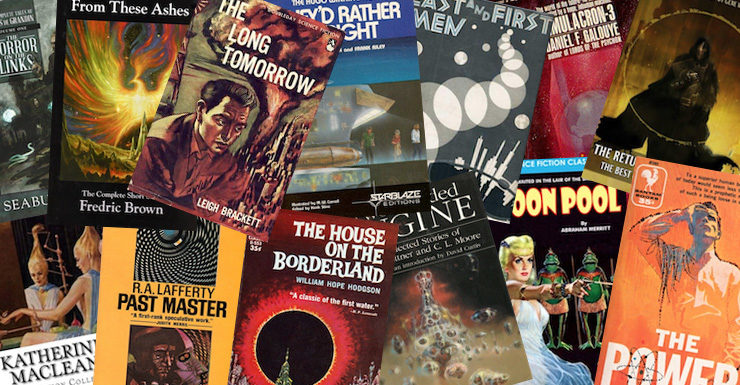Time is nobody’s friend. Authors in particular can fall afoul of time—all it takes is a few years out of the limelight. Publishers will let their books fall out of print; readers will forget about them. Replace “years” with “decades” and authors can become very obscure indeed.
The Cordwainer Smith Rediscovery Award was founded in 2001 to draw attention to unjustly forgotten SF authors. It is a juried award; the founding judges were Gardner Dozois, Robert Silverberg, Scott Edelman, and John Clute. The current judges are Elizabeth Hand, Barry N. Malzberg, Mike Resnick, and Robert J. Sawyer1.
I wish the award were more widely known, that it had, perhaps, its own anthology. If it did, it might look a bit like this. Who are the winners? Why should you care about them? I am so happy I pretended you asked. In order of victory, from 2001 to 2018:
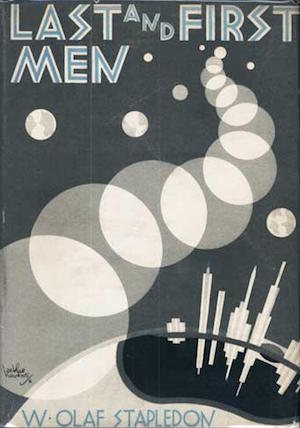
Olaf Stapledon (10 May 1886–6 September 1950) could write narrow focus novels when he wanted to. Sirius, for example, focuses on the life of an intelligent dog, while Odd John is the biography of a super-genius in a world that’s not ready for him. But Stapledon excelled at the epic: wide-focus visions of the past and future. Last and First Men covers the history of eighteen distinct human species over two billion years. Star Maker is even more ambitious; it narrates a history of the universe.
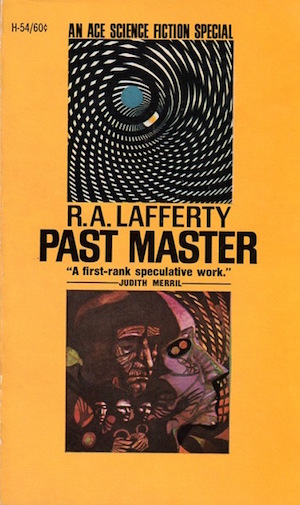
R.A. Lafferty (November 7, 1914–March 18, 2002) was not all that interested in plot. He excelled at setting and literary style. He’s not to everyone’s taste, but those who enjoy Lafferty’s work enjoy it intensely. Lafferty was sidelined by a long illness, during which time he was close to forgotten. In recent years publishers from Wildside to Centipede Press have brought his work back into print.
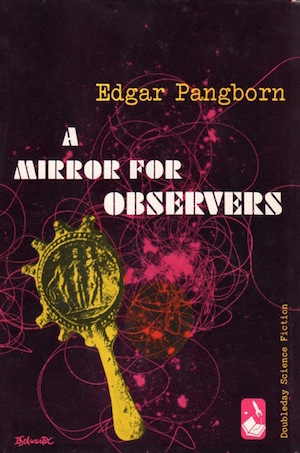
Edgar Pangborn (February 25, 1909–February 1, 1976) was active as a mystery writer for twenty years before he turned to science fiction in the 1950s. His humanist science fiction won fan acclaim. His novel A Mirror for Observers won the 1954 International Fantasy Award. Many of his later pieces form the Tales of a Darkening World sequence, set after war, plague, and climate change have reduced humanity to a tiny, barbaric remnant of today’s civilization. 1964’s Davy2 may be the best known in the series; I prefer the melancholy collection Still I Persist in Wondering. If read in publication order, Tales of a Darkening World betrays Pangborn’s increasingly pessimistic view of humans. Some early pieces are available on Gutenberg. SF Gateway’s Edgar Pangborn Omnibus is also in print.
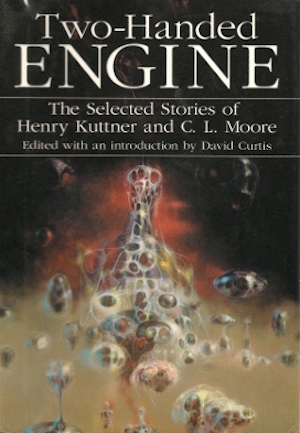
Henry Kuttner (April 7, 1915–February 3, 1958) and C. L. Moore (January 24, 1911–April 4, 1987) were both well-known authors before their mutual friend Howard Lovecraft introduced them. Once they married, they were a powerhouse writing team. Because they often collaborated, and because they sold the resulting works under whichever of their many bylines seemed most suitable, due credit for specific pieces can be difficult to establish. Thus it makes perfect sense to give them a joint award. My personal favourite of their collections is Two-Handed Engine, but it seems to be out of print. Look for the reprints of The Best of Henry Kuttner and The Best of C. L. Moore.
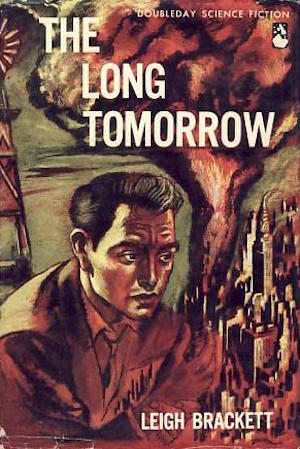
Leigh Brackett (December 7, 1915–March 18, 1978) was lauded for her planetary adventures (she moved her Eric John Stark adventures to the extra-solar world Skaith when space probes rendered her pulp-era Solar System implausible) but that was only one aspect of her work. In addition to writing SF and mysteries, she was a successful script writer. Her credits include The Big Sleep, Rio Bravo, The Long Goodbye, and an obscure little film called The Empire Strikes Back. Her planetary adventures tended to be long on action and short on clear moral boundaries. I am particularly fond of her post-apocalyptic The Long Tomorrow. Readers interested in her planetary adventures should look for the recent reprints of The Ginger Star, The Hounds of Skaith, and The Reavers of Skaith.
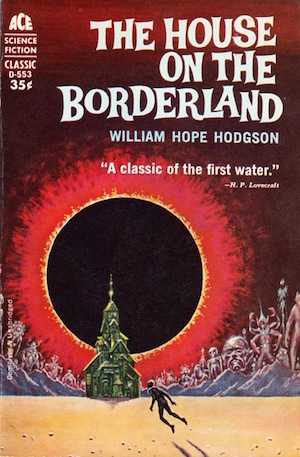
William Hope Hodgson (15 November 1877–19 April 1918) predated today’s formalized genre boundaries. One might think of him as working somewhere in the intersection of weird fantasy and cosmic horror. His best known works are the dying-Earth horror novel The Night Land and the hallucinatory The House on the Borderland. You may never have read either, but odds are you’ve read works influenced by one or the other. Hodgson died at Ypres, during WWI; hence several of his works are public domain and available at Project Gutenberg.
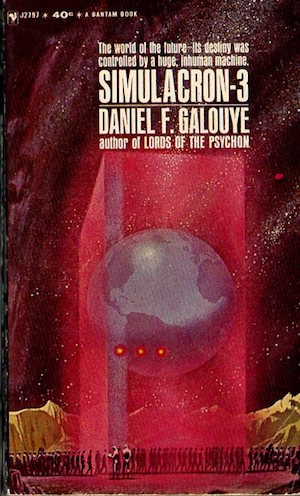
Daniel F. Galouye (11 February 1920–7 September 1976) was a journalist until health issues forced his retirement3. He was prolific. Many of his stories feature protagonists with unrealized potential and nowhere near enough information about their circumstances. His Counterfeit World AKA Simulachron-3 (filmed as The 13th Floor) seems the obvious starting point. A few of his works are available at Gutenberg.
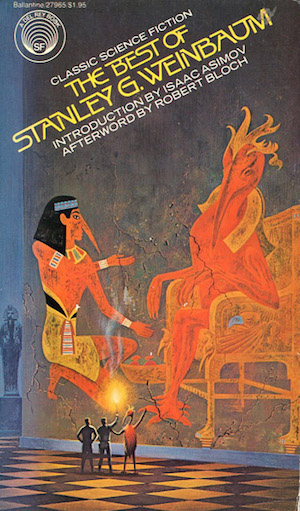
Stanley G. Weinbaum (April 4, 1902–December 14, 1935) died of cancer only eighteen months after his debut story A Martian Odyssey saw print. Although he dabbled in super-science, he seems to have by and large played fair with his readers. His oeuvre may be as close to hard SF as one might find in the 1930s. I recommend the ebook reprint of The Best of Stanley G. Weinbaum.

A. Merritt (January 20, 1884–August 21, 1943) found time during his active journalism career to pen eight science fantasy novels and an assortment of short stories. Readers curious about his vivid alternate worlds and, um, energetic prose could start with his classic The Moon Pool, available on Gutenberg.
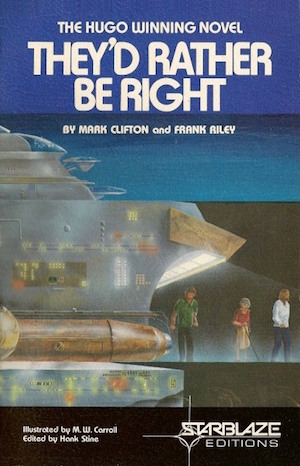
Industrial psychologist Mark Clifton (? 1906–November 1963) may be best known for winning the second Best Novel Hugo for They’d Rather Be Right, of which the less said the better. Much of his output focused on either the supercomputer Bossy (wise but distrusted by humans) and the Ralph Kennedy psionic tales. The story I’d suggest to anyone whom I didn’t actively dislike is the sentimental “Star, Bright,” whose view of super-kids is charmingly unhorrific. If you’ve annoyed me recently, then by all means track down They’d Rather Be Right.
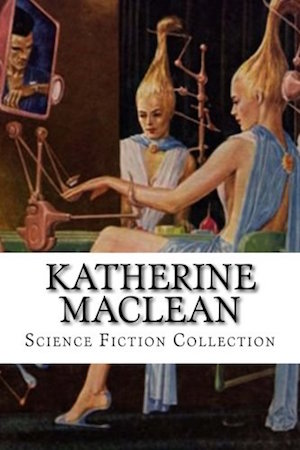
Although Katherine MacLean (January 22, 1925–) has written novels, it was an early flurry of short pieces (most published in the 1950s) that drew her to SF readers’ attention. Stories of particular note include “The Snowball Effect,” about sociological research that proves all too successful, “Pictures Don’t Lie,” about believing one’s eyes, and “And Be Merry,” in which a woman struggles with the terrors of immortality. There are many other MacLean stories worth reading. Alone of the names on this list, MacLean won the Rediscovery while still living. Although she has not published in the last generation, she is still alive and may yet break her silence.
As Samuel R. Delany has pointed out on Facebook, MacLean is an ideal candidate for Damon Knight Memorial Grand Master, which is given only to the living. Speaking for myself, I implore the SFWA to consider her for this award.
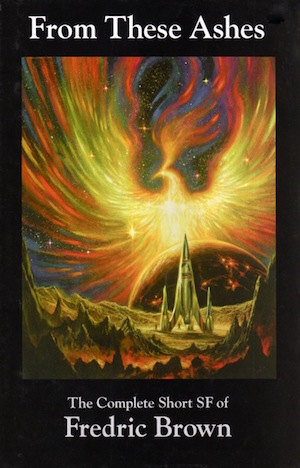
Fredric Brown (October 29, 1906–March 11, 1972) was, as previously discussed, a master of the short-short story, although he hardly restricted himself to that form. Readers interested in his novel-length material could look for his alternate universe comedy What Mad Universe, although I would lean more towards suggesting NESFA’s From These Ashes: The Complete Short Science Fiction of Fredric Brown.

Wyman Guin (March 1, 1915–February 19, 1989) is one of two authors who have won the Rediscovery whose work I have not managed to track down. Aside from his association with Galaxy Magazine, I know little about his fiction. Alas, he seems to be very, very thoroughly out of print.

Mildred Clingerman (March 14, 1918–February 26, 1997) is the other author in whose work I am not widely read. It’s not for lack of trying, because I’ve seen her work referenced favourably over the years. But! In the interval between writing my review of the Rediscovery Award Anthology I wish existed and composing this essay, The Clingerman Files was published. Not only does it contain her previously published work, it also includes some pieces previously unpublished. A copy is even now headed my way.

Clark Ashton Smith (January 13, 1893–August 14, 1961) was a mainstay of Weird Tales in the era of Lovecraft, Howard, and cover artist Margaret Brundage. Smith’s vivid, gleefully morbid tales featured protagonists not destined for long lives. But then, who would expect longevity for characters who proclaim
I am now at work on an apparatus by means of which, when it is perfected, I hope to manifest in their essential purity the radiations of malign force.
I can see no way in which that could go horribly wrong…
Readers new to Smith might consider Prime’s The Return of the Sorcerer.
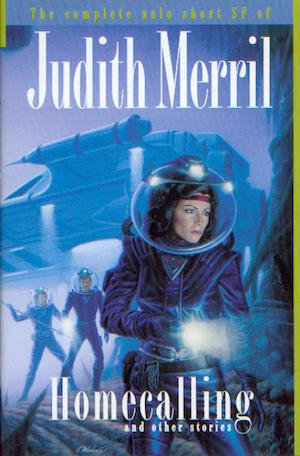
Writer, editor and activist Judith Merril (January 21, 1923–September 12, 1997) was a member of the Futurians, a fellowship of writers, editors, artists, and fans whose collective efforts guided science fiction away from Campbell’s narrow vision. Her noteworthy fiction includes the disturbing “That Only a Mother,” the co-written military SF novel Gunner Cade, and the post-holocaust Shadow on the Hearth. Readers new to Merril should look for a copy of Homecalling and Other Stories: The Complete Solo Short SF of Judith Merril.
Despite her accomplishments as a writer, it’s her role as an editor for which Merril is best known. Her variously titled The Year’s Greatest Science Fiction and Fantasy/Annual of the Year’s Best S-F ran from 1957 to 1968, followed by two Best of the Best volumes in 1970. Although there have been many Best SF annuals, Merril’s stood out for the breadth of the net she cast, drawing stories from well outside the usual borders of science fiction. She is to date the only woman to helm a best SF annual solo4.
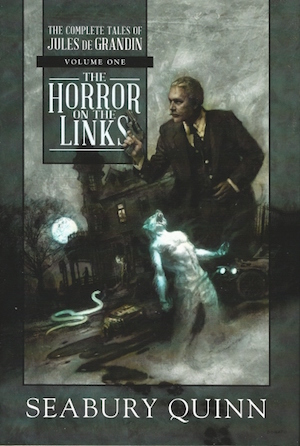
Seabury Quinn (January 1, 1889–December 24, 1969), first published in 1917, was a prolific contributor to Weird Tales (a magazine of which the judges for this award appear quite fond). Occult detective Jules de Grandin featured in many of them, enough to fill all three volumes of The Complete Tales of Jules de Grandin (Horror on the Links, The Devil’s Rosary, and The Dark Angel.).
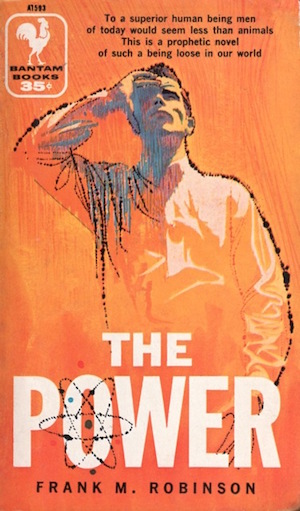
Activist Frank M. Robinson (August 9, 1926–June 30, 2014) in no way limited himself to writing fiction (his political activities won him a spot in the Chicago Gay and Lesbian Hall of Fame). Even his role in SF was wide-ranging…and long-lived. His sixteen novels ranged from psionic thriller The Power to the generation ship Bildungsroman The Dark Beyond the Stars. With Thomas Scortia he was author of several successful thrillers, ranging from The Glass Inferno (which contributed to the ensemble disaster film The Towering Inferno), The Prometheus Crisis, The Nightmare Factor, and The Gold Crew.
Who will be the next winner of this award? Not being a judge, I couldn’t say. But I am very curious to find out.
1: Unfortunately the Cordwainer Smith Foundation site stopped updating their list of Rediscovery winners in 2012 (although Wikipedia keeps a list), because, if I understand a recent email exchange correctly, they thought File 770 was preserving information about the award. While File 770 does report on the award (and is where I got the list of judges), this is simply part of their general news reporting activities.
2: Readers may find the 1976 Vallejo cover a bit risqué. Surprisingly enough, it is true to the text—save for one detail. Davy is wearing cut-offs. In his time, such tailored trousers are a lost technology. Consider how much technology had to be lost for that to be true.
3: A fair fraction of Rediscovery winners enjoyed short lives, whether thanks to the lingering (or in the case of Hodgson, immediate) effects of military careers or to simple bad health.
4: Paula Guran has published two Best-of anthologies that cover both SF and fantasy. Forty-seven years passed between Merril’s final Best-of and Guran’s first.
In the words of Wikipedia editor TexasAndroid, prolific book reviewer and perennial Darwin Award nomineeJames Davis Nicoll is of “questionable notability.” His work has appeared in Publishers Weekly and Romantic Times as well as on his own websites, James Nicoll Reviews and Young People Read Old SFF (where he is assisted by editor Karen Lofstrom and web person Adrienne L. Travis). He is surprisingly flammable.










